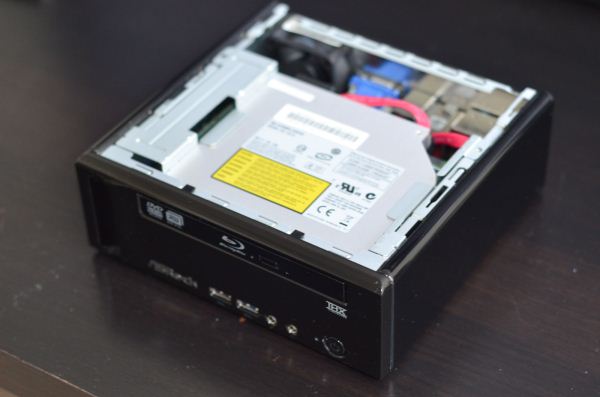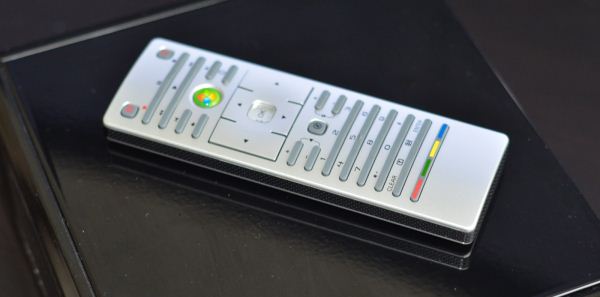ASRock CoreHT Server Edition Review
by Vivek Gowri on February 16, 2012 9:00 AM EST- Posted in
- Systems
- Intel
- ASRock
- Media Streamer
- HTPC
Take a Look Inside
As with the CoreHT 252B, the Server is built around notebook internals. Let’s break it down.

CPU/GPU: Intel Core i5-2410M/HD 3000
The i5-2410M is a 32nm mobile Sandy Bridge part, clocked at 2.3GHz with a maximum turbo frequency of 2.9GHz. It’s a dual-core, 4-thread part that has a 35W TDP and a maximum clock of 1.2GHz for the on-die HD 3000 graphics core.
Chipset: Intel HM67
Interestingly, the motherboard has HM65 printed on it and the chipset even has a sticker on it identifying itself as an HM65 part. This would make any kind of RAID problematic, because the HM65 chipset doesn’t have an onboard RAID controller. This appears, however, to be a simple problem of mislabeling, because the chip is pretty clearly based on the Cougar Point HM67 platform (as identified in CPU-Z), with the two hard drives set up in RAID 0. Functionally, the only difference between HM65 and HM67 is the inclusion of the onboard RAID controller. Otherwise, the board is basically the same as the the one found in the CoreHT-252B.
Storage: 2 x 500GB 7200RPM, RAID 0
The star of the show here, the hard drive array, is made up of two 2.5” 500GB 7200RPM SATA hard drives arranged in a RAID 0 configuration to form a single 1TB volume. The two drives aren’t matched, with one being a Hitachi HTS7250 and the other being a Western Digital WD5000, but the specs are very similar. We will cover performance shortly, but it’s quite good.

Beyond the main features, there are two SoDIMMs of 2GB DDR3 1333 for a total of 4GB system memory, along with an Atheros AR9287 wireless card and the same Phillips Lite-On DS-4E1S Blu-ray combo drive as the 252B.
A special mention for the media center remote—it’s the same one as the CoreHT 252B, but I didn’t dislike it as much as Ganesh did. It feels light in hand, but not of poor build quality, and it’s relatively compact given the number of buttons on it. This leads to rather small buttons, but it’s something you can adjust to unless you have huge hands. Personally, I prefer remotes closer in form and function to the Boxee remote and such, but I found the CoreHT remote to be decent.











44 Comments
View All Comments
Bejusek - Thursday, February 16, 2012 - link
I admit that 1TB is scarce, but 18TB is a bit of overkill for me. Your words only confirm my opinion that 'server edition' is a joke.Metaluna - Friday, February 17, 2012 - link
Not just 1TB, but 1TB in Raid 0. As in, even less reliable than a single 1TB drive, just to gain a bit of performance that has questionable benefit in a small file server anyway. In other words, they don't get it.The name is probably just marketing, to align it with the Mac Mini Server, which also has two hard drives.
faizoff - Thursday, February 16, 2012 - link
The idle CPU temp seems a bit high though honestly I don't know the expected standard for HTPCs. My i5 2500k idles at 29-32 C, I'd always assumed HTPCs idle at around the same or less.Death666Angel - Thursday, February 16, 2012 - link
Considering that this temp does not negatively affect anything (like performance, life span etc.) it is really not interesting. They probably made the decision to go with more lenient fan controls. Nothing wrong with that. :-)faizoff - Thursday, February 16, 2012 - link
Well it was interesting to me since at idle in an HTPC there are a lot less resources running when compared to a desktop. Plus I always thought they would consume less power and generate less heat when compared to a desktop.Just some assumptions I formed I guess.
Death666Angel - Thursday, February 16, 2012 - link
Less power and therefore less heat, sure. But also small enclosure, smaller heatsinks, smaller fans etc. Those things go together, so just less heat doesn't mean lower temps. Just look at small notebooks with 35W CPUs, they regularly have higher temps than 95W desktop CPUs. :-)duploxxx - Thursday, February 16, 2012 - link
From the first review it was already clear that the Intel onboard GPU is just not up to the task to fully utilize where a HTPC is build for, this update doesn't change anything, hence even don't understand why bother to review again, There are other platforms much better suited then this. On top of that why bother with those few benchmarks, the cpu is know for a long time, these benchmarks are no real added value.Scannall - Thursday, February 16, 2012 - link
Without a way to put better graphics in it, I am wondering why they didn't go with a mobile Llano CPU instead.queequeg99 - Thursday, February 16, 2012 - link
Maybe they're thinking that heavy duty transcoding is more important than casual gaming for the intended audience. I ran into the same choice a few months ago. Fortunately, all of my video files are in a single format and no transcoding is necessary with the software I use. However, I would like the ability to play the occasional game of Portal. The A8-3850 works perfectly for that purpose.capeconsultant - Thursday, February 16, 2012 - link
What is up with that?